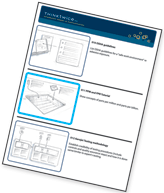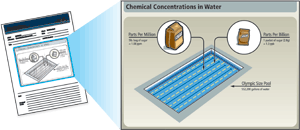|
|
|
|
|
|
|
|
|
|
|
ArticlesLitigation Support: Content & ContextIt's often suggested that to keep a jury's attention in this age of television and video games, you've got to put on a graphics show. Neither society at large, nor the jury pool, suffers from collective attention deficit disorder. The reason for using graphic support is simply because it represents the most effective means to communicate volumes of information. Studies have found that 65 percent of Americans are primarily visual learners, which is to say: a vast majority of us get most of our knowledge through our eyes. If jurors' attention tends to wander, it may be because they are at a terrible disadvantage. They've been plucked from their everyday lives and are being asked to find fact in a matter for which they have no context (story) and where the content (parties, subject matter, evidence and law) is foreign. The goal for successful use of visual information is to give your audience the context and the content to find in your favor. To do that, a presentation should follow this path: educate, advocate and - finally - motivate the audience. How can this be achieved? Regardless of whether you are preparing a Microsoft PowerPoint program in-house, or you are managing a graphics consultant contracted to develop a complex multimedia presentation, understanding the creative process will help you get successful results. Do Discovery
Tell A Story
Develop A Presentation Strategy
Do this for each major theme and you'll build a solid foundation for - and most importantly, a memorable impression of - your argument. The tried and true journalist's mantra, "Tell them what you're going to tell them, tell them, then tell them what you told them" is a good formula for visual as well as oral arguments. Your strategy will vary depending on what stage of litigation you are in. Graphics can be just as successful educating judges during motion hearings, markman hearings, tutorials or mediations as they can be in front of a jury. Don't think of graphics just for trial, consider how graphics can help in other situations. Even with focus groups or mock trials, graphics offer an efficient shorthand to communicate "evidence" quickly. Create A Visual Outline Develop your story as an "exhibit plan" with thumbnail
sketches and brief Use sketches in your exhibit plan to illustrate the global view of your graphic story - and to ensure your case themes are developed adequately in demonstratives, without holes or overlaps. It also defines the scope of the project and lets you or your graphics consultant budget time accordingly. Additionally, the exhibit plan becomes a working document that gets your trial team on the same page in regard to presentation. Prepare The Visual Argument Start by developing a template that standardizes colors, fonts, type sizes and basic layout and design. It should be flexible enough to accommodate the variety of graphics outlined in the exhibit plan: timelines, tables, diagrams, document treatments and simple text - such as bullet lists. Produce the graphics using source materials and tools you identified earlier. Complete your presentation by putting the final touches on your PowerPoint presentation or editing and approving proofs from your graphics vendor -- then load them up into your trial presentation software. Institute a naming convention that identifies each type of file and avoids overlapping names. Generally a three or four digit identifier works, but you may want to add a prefix to distinguish exhibits from demonstratives. Keep a mirrored database of all your graphic elements on a secure server in case the laptop you take to court fails or is lost. Rehearse It is crucial to spend time rehearsing so you are comfortable using your graphics. If you (or one of your colleagues) will be running the presentation system in court, be sure you know at least the basic functions. If a trial technician will run the system, rehearse your presentation and discuss the cues you'll use to call up graphics. Present! Ultimately, the presentation is largely about the presenter. In front of the court, graphics are there to support the star - you. By defining communication goals, crafting a compelling story, planning a cohesive set of visuals with supporting evidence, and rehearsing, you'll be prepared to make a persuasive and memorable argument.
Craig Veconi is Director of Client Services for Think Twice, Inc., a litigation graphics and trial presentation consultancy based in San Francisco. E-mail: craig@thinktwicelegal.com.
This article is reprinted with permission from the February issue of Law Technology News ©2005 ALM Properties Inc Further duplication without permission is prohibited. All rights reserved. |
|
Obiter Dictum
|
|
 Apart from evidentiary discovery, identify the source materials,
graphic elements (diagrams, video, photography), case themes and communication
goals that will influence your presentation. Consider input from your
jury consultant and expert witnesses. Find sources for assets that
fill the holes. These may include illustrators, animators, videographers,
graphic designers etc. If you are using a graphics consultant, he
or she probably has these talents on staff or has relationships with
specialists. (Caveat: If you try to search photography, medical or
technical illustrations online, be aware of copyright and trademark
rights.)
Apart from evidentiary discovery, identify the source materials,
graphic elements (diagrams, video, photography), case themes and communication
goals that will influence your presentation. Consider input from your
jury consultant and expert witnesses. Find sources for assets that
fill the holes. These may include illustrators, animators, videographers,
graphic designers etc. If you are using a graphics consultant, he
or she probably has these talents on staff or has relationships with
specialists. (Caveat: If you try to search photography, medical or
technical illustrations online, be aware of copyright and trademark
rights.)  Researchers have shown that jurors assemble the facts they hear -
from both sides, as contradictory and incongruous as they may be -
into stories that seem plausible and rational given the juror's knowledge
and life experience. Where there are holes in their stories, jurors
will often create elements to bridge the gaps. For better or worse,
jurors then base verdicts on these stories, so creating a clear picture
of "what happened" is critical in order to inspire the jury
to reach a favorable conclusion. Plot your key themes in a compelling
and logical progression.
Researchers have shown that jurors assemble the facts they hear -
from both sides, as contradictory and incongruous as they may be -
into stories that seem plausible and rational given the juror's knowledge
and life experience. Where there are holes in their stories, jurors
will often create elements to bridge the gaps. For better or worse,
jurors then base verdicts on these stories, so creating a clear picture
of "what happened" is critical in order to inspire the jury
to reach a favorable conclusion. Plot your key themes in a compelling
and logical progression. Create a plan for visually presenting your case. It should be appropriate
to the venue, audience(s), time allowed and your comfort with the
means of presentation (e.g.: display boards, Elmo, trial presentation
system or a combination). Use your graphic tools to provide overviews
and summaries, and to dive deeper into specific exhibits for supporting
details.
Create a plan for visually presenting your case. It should be appropriate
to the venue, audience(s), time allowed and your comfort with the
means of presentation (e.g.: display boards, Elmo, trial presentation
system or a combination). Use your graphic tools to provide overviews
and summaries, and to dive deeper into specific exhibits for supporting
details.
